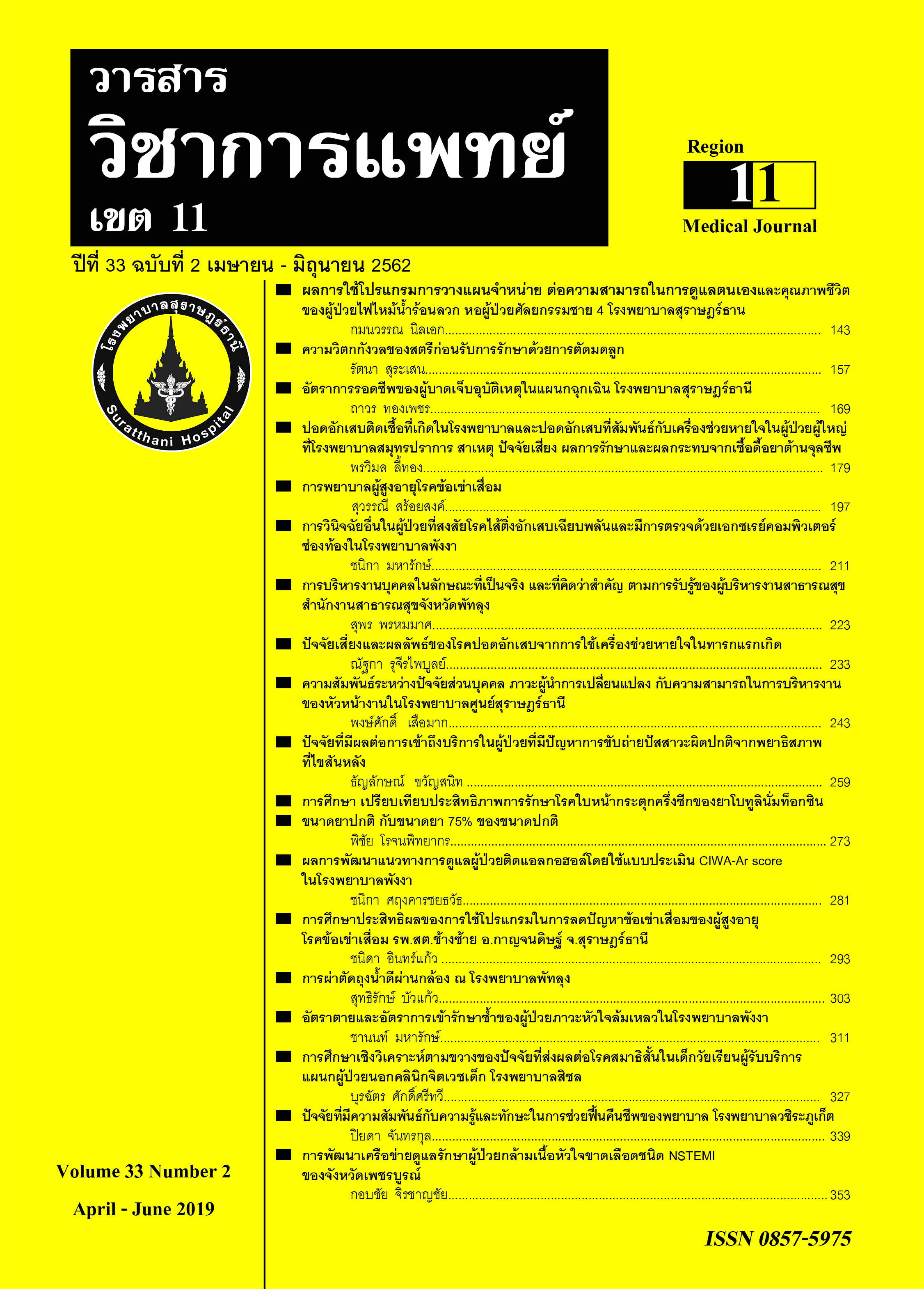Hemifacial spasm: comparative study efficacy of treatment with 75% dose and normal dose botulinum toxin injection
Keywords:
low dose botulinum toxin, hemifacial spasmAbstract
Objective: To explore the efficacy of low 75 % dose botulinum toxin A (BTA) comparison to normal dose treatment for hemifacial spasm (HFS).
Method: A randomized single-blinded prospective trial with BTA injection at the botulinum Clinic in Suratthani Hospital, Thailand. The patients who were attended in January 2019 and were evaluated in April 2019. The single-blind patients were random by alternative patients 1:1 to assess outcome. Low dose BTA diluted to get the same volume of normal dose.
Result: A total of 69 patients with HFS include 34 patients in normal dose group and 35 patients in low dose group. There were female more than male in both groups. The mean ages were 59 years and 60 years. The left side was more affected the same. The mean number of injection were 12.5 times in normal group and 11 times in low dose group. The mean dose of treatment was 65.3 units in normal dose and 46.1 in 75% dose. The mean duration between treatments were 2.9 months and 3 months. The outcome of treatment was assessed at appointment after injection for 3 months by the patients. The outcome of treatment was not significantly difference in both groups. Most patients had fair improvement in 17 patients (50%) in normal dose and 15 patients (43%) in low dose. Most treatments had no complication in 97-100 %.We reduce the cost by 2,648 bath per person per year.
Conclusion: 75% dose BTA injection was an effective treatment for hemifacial spasm patients none inferiority than normal dose. There was maintain duration response as same as normal dose and low complication rate in this study.
References
botulinum toxin injection techniques. Neurol Sci. 2017 ;38(11):2031-6.
2. Karp BI, Alter K. Botulinum Toxin Treatment of Blepharospasm, Orofacial /Oromandibular Dystonia, and Hemifacial Spasm. Semin Neurol. 2016 ;36(1):84-91.
3. Dong H, Fan S, Luo Y, Peng B. Botulinum toxin relieves anxiety and depression in patients with hemifacial spasm and blepharospasm. Neuropsychiatr Dis Treat. 2019;15:33-6.
4. Elston J S MP, ed., editors. Indiopathic blepharospasm, hemifacial spasm and therapeutic ptosis induction.1995.
5. Costa J, Espirito-Santo C, Borges A, Ferreira JJ, Coelho M, Moore P, et al. Botulinum toxin type A therapy for hemifacial spasm. Cochrane Database Syst Rev. 2005 Jan 25(1):CD004899.
6. Batisti JP, Kleinfelder AD, Galli NB, Moro A, Munhoz RP, Teive HA. Treatment of hemifacial spasm with botulinum toxin type a: effective, long lasting and well tolerated. Arq Neuropsiquiatr. 2017;75(2):87-91.
7. Schellini SA, Matai O, Igami TZ, Padovani CR, Padovani CP. [Essential blepharo spasm and hemifacial spasm: characteristic of the patient, botulinum toxin A treatment and literature review]. Arq Bras Oftalmol. 2006 ;69(1):23-6.
8. Jitpimolmard S, Tiamkao S, Laopaiboon M. Long term results of botulinum toxin type A (Dysport) in the treatment of hemifacial spasm: a report of 175 cases. J Neurol Neurosurg Psychiatry. 1998 ;64(6):751-7.
9. Astarloa R, Morales B, Sanchez V, Penafiel N, Rabano J, Olivan J, et al. [Focal dystonias and facial hemispasm: treatment with botulinum A toxin]. Arch Neurobiol (Madr). 1991;54(5):210-7.
10. Poungvarin N, Viriyavejakul A. Two hundred and fifty patients with hemifacial spasm treated with botulinum toxin injection. J Med Assoc Thai. 1992;75(4):199-203.
11. Yoshimura DM, Aminoff MJ, Tami TA, Scott AB. Treatment of hemifacial spasm with botulinum toxin. Muscle Nerve. 1992 ;15(9):1045-9.
12. Suputtitada A, Phanthumchinda K, Locharernkul C, Suwanwela NC. Hemifacial spasm: results of treatment with low dose botulinum toxin injection. J Med Assoc Thai. 2004 ;87(10):1205-11.
13. Van den Bergh P, Francart J, Mourin S, Kollmann P, Laterre EC. Five-year experience in the treatment of focal movement disorders with low-dose Dysport botulinum toxin. Muscle Nerve. 1995 ;18(7):720-9.
14. Lee JA, Jo KW, Kong DS, Park K. Using the new clinical grading scale for quantification of the severity of hemifacial spasm: correlations with a quality of life scale. Stereotact Funct Neurosurg. 2012;90(1):16-9.
15. Shah A, Horowitz M. Persistent hemifacial spasm after microvascular decompression: a risk assessment model. Br J Neurosurg. 2017 ;31(3):327-35.
16. Dutton JJ, Buckley EG. Long-term results and complications of botulinum A toxin in the treatment of blepharospasm. Ophthalmology. 1988 ;95(11):1529-34.
17. Hubble J, Schwab J, Hubert C, Abbott CC. Dysport (botulinum toxin type A) in routine therapeutic usage: a telephone needs assessment survey of European
physicians to evaluate current awareness and adherence to product labeling changes. Clin Neuropharmacol. 2013 ;36(4):122-7.
18. Bigalke H, Wohlfarth K, Irmer A, Dengler R. Botulinum A toxin: Dysport improvement of biological availability. Exp Neurol. 2001 ;168(1):162-70.






